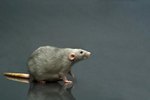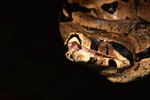
Contrary to popular thought, snakes will often accept dead prey items as food. Feeding snakes frozen-thawed rodents makes their husbandry easier and safer. Though some keepers continue to feed their snakes live food, most professional breeders, zoos and experienced hobbyists feed their snakes thawed frozen rodents.
Live Rodents
Though there are exceptions, like cottonmouths (Agkistrodon piscivorous) and brown tree snakes (Boiga irregularis), the vast majority of wild snakes consume live prey. However, live prey often fights back; sometimes with serious consequences. Most often, snakes are bitten after catching and constricting a rodent, and then losing partial control of the mouse or rat. As the rodent is frightened and partially free, it is able to bite the snake on the head or back. Sometimes, rodents can become the aggressor when paired with a timid snake. An additional concern is that live food must be cared for humanely before being offered to the snake.
Frozen Rodents
Feed frozen rodents to all snakes that will accept them. Frozen rodents are much safer as they do not fight back, and can’t harm your snake. Frozen rodents can be purchased online in bulk and then shipped to your home, making them much cheaper and easier to acquire than live rodents.The frozen rodents must be stored in the freezer, which is off-putting to some keepers. An additional drawback to using frozen rodents is that thawing rodents is time-consuming and can be messy.
Non-Rodent Prey
Frozen snake food generally refers to mice and rats; but rabbits, chicks, quail, frogs and fish are also sometimes fed to snakes. Frozen rabbits, chicks and quail are often available from the same suppliers as their smaller cousins are, and can be thawed and presented in the same manner. Frozen frogs and fish are available at grocery stores and can be fed to appropriate snakes after they are thawed. Ensure that the frogs and fish are unprocessed and aren’t packed in oil. The freezing process can disrupt the life cycle of some parasites, and this can be exceptionally helpful with feeders like frogs and fish, which are often highly parasitized.
Stubborn Feeders
While most snakes will readily accept thawed frozen rodents, some accept only live prey. In order to switch a problem feeder to a frozen rodent diet, you must condition the animal to expect two food items per feeding. To do this, offer the snake one live prey item and let the snake completely consume it. After giving the snake a few minutes to align its jaw and recover, present it with a second live-prey item. After doing this for a few weeks, substitute a frozen thawed mouse or rat for the second rodent. Be sure to use hemostats or tongs to make the rodent move as though it is alive. Eventually, it will become possible to skip the first live rodent entirely, offering only a thawed frozen rodent.
References
- Melissa Kaplan's Herp Care Collection: Feeding Live vs. Frozen Prey
- Homes Alive: Feeding Live vs. Frozen and Your Reptile
- University of Nebraska, Lincoln: Carrion Seeking in Brown Tree Snakes: Importance of Olfactory and Visual Cues
- Melissa Kaplan's Herp Care Collection: Reptile Veterinarians and Zoo Reptile Curators on Feeding Live Rodent Rrey
- Seafood Network Information Center: Freezing to Kill Nematode Parasites in Fish Products
Photo Credits
-
NA/AbleStock.com/Getty Images




